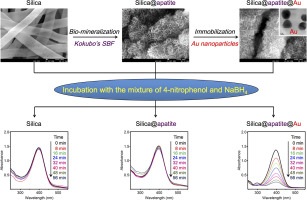当前位置:
X-MOL 学术
›
Mater. Des.
›
论文详情
Our official English website, www.x-mol.net, welcomes your
feedback! (Note: you will need to create a separate account there.)
Facile synthesis of novel fibrous silica@apatite@Au composites with superior photo-catalytic activity
Materials & Design ( IF 7.6 ) Pub Date : 2018-06-01 , DOI: 10.1016/j.matdes.2018.03.038 Song Chen , Tianlong Wang , Yunhong Yao , Aili Wei
Materials & Design ( IF 7.6 ) Pub Date : 2018-06-01 , DOI: 10.1016/j.matdes.2018.03.038 Song Chen , Tianlong Wang , Yunhong Yao , Aili Wei

|
Abstract Novel fibrous silica@apatite@Au composites with superior photo-catalytic activity were facilely synthesized through combination of electrospinning technique, bio-mineralization, and in situ immobilization. Silica nanofibers with the diameter of 486 ± 60 nm were synthesized through electrospinning of the sol-gel mixture of gelatin, tetraethoxysilane, acetic acid, water, and calcium chloride followed by sintering process. After bio-mineralization in the Kokubo's simulated body fluid, silica nanofibers supported in situ deposition of fibrous apatite nanosheet flowers to produce fibrous silica@apatite composites. SEM observations showed that the silica@apatite composites had the fibrous feature with the diameter of 2498 ± 608 nm and their surface was very rough and constructed by numerous apatite nanosheets with the thickness around 10 nm. XRD patterns showed that the fibrous silica@apatite composites presented the characteristic diffraction peaks at 26° and 32° assigned to apatite components. FT-IR spectra revealed that silica@apatite composites contained both Si O Si bonds and P O P groups. After immersion in the suspension of Au nanoparticles, the silica@apatite composites supported the in situ immobilization of Au nanoparticles to produce silica@apatite@Au composites. When incubated in the aqueous mixture of 4-nitrophenol and NaHB4, the fibrous silica@apatite@Au composites presented a superior photo-catalytic activity and rapidly catalyzed the reduction of 4-nitrophenol to 4-aminophenol.
中文翻译:

轻松合成具有优异光催化活性的新型纤维状二氧化硅@磷灰石@Au复合材料
摘要 通过静电纺丝技术、生物矿化和原位固定化相结合,合成了具有优异光催化活性的新型纤维状二氧化硅@磷灰石@Au复合材料。通过对明胶、四乙氧基硅烷、乙酸、水和氯化钙的溶胶-凝胶混合物进行静电纺丝,然后进行烧结工艺,合成了直径为 486 ± 60 nm 的二氧化硅纳米纤维。在 Kokubo 的模拟体液中进行生物矿化后,二氧化硅纳米纤维支持纤维状磷灰石纳米片花的原位沉积,以产生纤维状二氧化硅@磷灰石复合材料。SEM观察表明,二氧化硅@磷灰石复合材料具有直径为2498±608 nm的纤维状特征,其表面非常粗糙,由大量厚度约10 nm的磷灰石纳米片构成。XRD 谱表明,纤维状二氧化硅@磷灰石复合材料在 26° 和 32° 处呈现出属于磷灰石组分的特征衍射峰。FT-IR 光谱显示二氧化硅@磷灰石复合材料同时含有 Si O Si 键和 POP 基团。在浸入 Au 纳米颗粒的悬浮液中后,二氧化硅@磷灰石复合材料支持 Au 纳米颗粒的原位固定以制备二氧化硅@磷灰石@Au 复合材料。当在 4-硝基苯酚和 NaHB4 的水性混合物中孵育时,纤维状二氧化硅@磷灰石@Au 复合材料表现出优异的光催化活性,并迅速催化 4-硝基苯酚还原为 4-氨基苯酚。FT-IR 光谱显示二氧化硅@磷灰石复合材料同时含有 Si O Si 键和 POP 基团。在浸入 Au 纳米颗粒的悬浮液中后,二氧化硅@磷灰石复合材料支持 Au 纳米颗粒的原位固定以制备二氧化硅@磷灰石@Au 复合材料。当在 4-硝基苯酚和 NaHB4 的水性混合物中孵育时,纤维状二氧化硅@磷灰石@Au 复合材料表现出优异的光催化活性,并迅速催化 4-硝基苯酚还原为 4-氨基苯酚。FT-IR 光谱显示二氧化硅@磷灰石复合材料同时含有 Si O Si 键和 POP 基团。在浸入 Au 纳米颗粒的悬浮液中后,二氧化硅@磷灰石复合材料支持 Au 纳米颗粒的原位固定以制备二氧化硅@磷灰石@Au 复合材料。当在 4-硝基苯酚和 NaHB4 的水性混合物中孵育时,纤维状二氧化硅@磷灰石@Au 复合材料表现出优异的光催化活性,并迅速催化 4-硝基苯酚还原为 4-氨基苯酚。
更新日期:2018-06-01
中文翻译:

轻松合成具有优异光催化活性的新型纤维状二氧化硅@磷灰石@Au复合材料
摘要 通过静电纺丝技术、生物矿化和原位固定化相结合,合成了具有优异光催化活性的新型纤维状二氧化硅@磷灰石@Au复合材料。通过对明胶、四乙氧基硅烷、乙酸、水和氯化钙的溶胶-凝胶混合物进行静电纺丝,然后进行烧结工艺,合成了直径为 486 ± 60 nm 的二氧化硅纳米纤维。在 Kokubo 的模拟体液中进行生物矿化后,二氧化硅纳米纤维支持纤维状磷灰石纳米片花的原位沉积,以产生纤维状二氧化硅@磷灰石复合材料。SEM观察表明,二氧化硅@磷灰石复合材料具有直径为2498±608 nm的纤维状特征,其表面非常粗糙,由大量厚度约10 nm的磷灰石纳米片构成。XRD 谱表明,纤维状二氧化硅@磷灰石复合材料在 26° 和 32° 处呈现出属于磷灰石组分的特征衍射峰。FT-IR 光谱显示二氧化硅@磷灰石复合材料同时含有 Si O Si 键和 POP 基团。在浸入 Au 纳米颗粒的悬浮液中后,二氧化硅@磷灰石复合材料支持 Au 纳米颗粒的原位固定以制备二氧化硅@磷灰石@Au 复合材料。当在 4-硝基苯酚和 NaHB4 的水性混合物中孵育时,纤维状二氧化硅@磷灰石@Au 复合材料表现出优异的光催化活性,并迅速催化 4-硝基苯酚还原为 4-氨基苯酚。FT-IR 光谱显示二氧化硅@磷灰石复合材料同时含有 Si O Si 键和 POP 基团。在浸入 Au 纳米颗粒的悬浮液中后,二氧化硅@磷灰石复合材料支持 Au 纳米颗粒的原位固定以制备二氧化硅@磷灰石@Au 复合材料。当在 4-硝基苯酚和 NaHB4 的水性混合物中孵育时,纤维状二氧化硅@磷灰石@Au 复合材料表现出优异的光催化活性,并迅速催化 4-硝基苯酚还原为 4-氨基苯酚。FT-IR 光谱显示二氧化硅@磷灰石复合材料同时含有 Si O Si 键和 POP 基团。在浸入 Au 纳米颗粒的悬浮液中后,二氧化硅@磷灰石复合材料支持 Au 纳米颗粒的原位固定以制备二氧化硅@磷灰石@Au 复合材料。当在 4-硝基苯酚和 NaHB4 的水性混合物中孵育时,纤维状二氧化硅@磷灰石@Au 复合材料表现出优异的光催化活性,并迅速催化 4-硝基苯酚还原为 4-氨基苯酚。











































 京公网安备 11010802027423号
京公网安备 11010802027423号